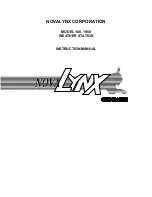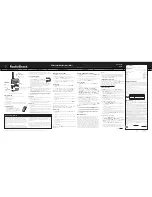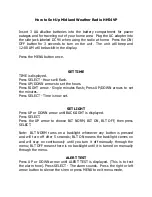
tuning" of the wind direction meter. A three position switch allows the operator to select
the wind direction sensor, the calibration mode, or to disconnect the battery. Whenever
readings are to be made infrequently, it is recommended that the wind direction circuit be
disconnected to increase the life of the battery.
5.0
CALIBRATION
5.1
Wind Speed
Adjust the wind speed circuit by first setting the range switch to the Low range position.
Remove the anemometer cups and attach a wind speed spin-up motor to the generator
shaft. Rotate the shaft at a constant 300 rpm. For the standard wind sensor, the 300 rpm
represents 18.5 mph ( 8.2 m/s ). Adjust the wind speed range potentiometer located on
the signal conditioning circuit. If possible check the circuit operation at a higher wind speed
by rotating the anemometer shaft at one of the higher rpm values shown, such as 600 rpm.
Please note that the anemometer calibration is fixed and is determined by wind tunnel
tests. There is no adjustment as to the mph vs rpm values. Should the anemometer cups
become damaged the response of the cups to the wind will be affected and will result in
errors in the meter readings. Replace damaged cups as soon as possible. Worn
generator bearings can also result in wind speed errors. Replace the anemometer
bearings at least annually, and especially in areas that experience constant wind activity.
5.2
Wind Direction
As the vane rotates in a clockwise direction as viewed from above the sensor, the meter
will increase its reading from zero to 360 to a maximum indication of East. The full-scale
reading will vary as the battery loses its power over time. The full-scale adjustment should
be checked before taking readings, especially if readings are taken infrequently. Set the
front panel switch to the calibration check position. The sensor should be connected to the
meter circuit during this test. Adjust the front panel control until a full-scale reading is
obtained. If it is difficult to make the adjustment, it may be an indication that the battery
needs to be replaced. Notice that the full-scale deflection of the meter is East, or 90
degrees Azimuth.
5.3
Temperature
The temperature meter and capillary tube do not have any user available adjustments.
The only check that can be made is to place the temperature sensor into a controlled or
stable temperature bath and compare the reading with that of glass thermometer or
another electronic thermometer. For temperature readings that appear to be slightly off
during the temperature check, make note of the difference and apply the value to the meter
readings whenever a reading is taken. Should the temperature reading appear to be
substantially in error the temperature sensor and meter may need replacement. Contact
5




























